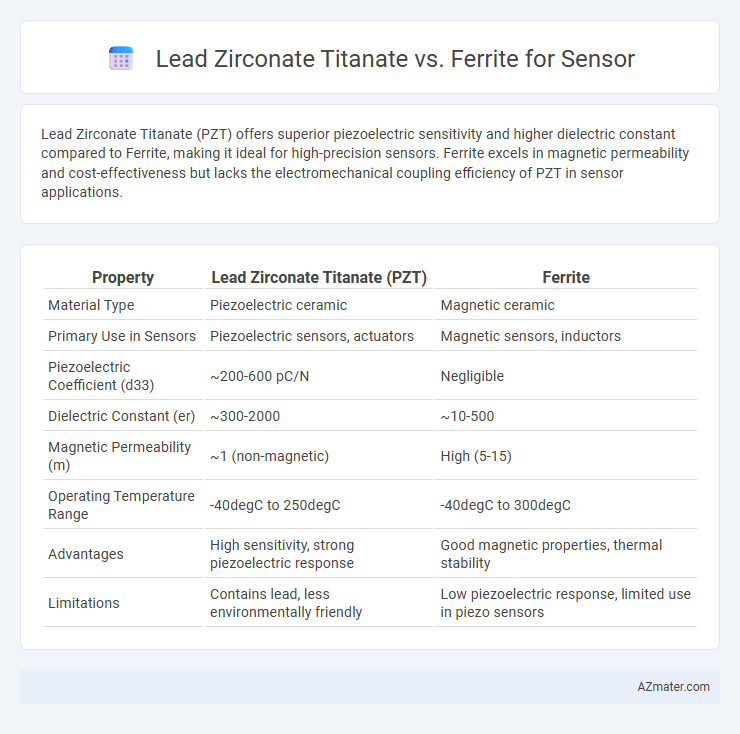Lead Zirconate Titanate (PZT) offers superior piezoelectric sensitivity and higher dielectric constant compared to Ferrite, making it ideal for high-precision sensors. Ferrite excels in magnetic permeability and cost-effectiveness but lacks the electromechanical coupling efficiency of PZT in sensor applications.
Table of Comparison
| Property | Lead Zirconate Titanate (PZT) | Ferrite |
|---|---|---|
| Material Type | Piezoelectric ceramic | Magnetic ceramic |
| Primary Use in Sensors | Piezoelectric sensors, actuators | Magnetic sensors, inductors |
| Piezoelectric Coefficient (d33) | ~200-600 pC/N | Negligible |
| Dielectric Constant (er) | ~300-2000 | ~10-500 |
| Magnetic Permeability (m) | ~1 (non-magnetic) | High (5-15) |
| Operating Temperature Range | -40degC to 250degC | -40degC to 300degC |
| Advantages | High sensitivity, strong piezoelectric response | Good magnetic properties, thermal stability |
| Limitations | Contains lead, less environmentally friendly | Low piezoelectric response, limited use in piezo sensors |
Overview of Lead Zirconate Titanate (PZT) and Ferrite Materials
Lead Zirconate Titanate (PZT) is a piezoelectric ceramic known for its high dielectric constant, strong piezoelectric coefficients, and excellent electromechanical coupling, making it ideal for precise sensor applications such as accelerometers and pressure sensors. Ferrite materials, primarily magnetic oxides like manganese-zinc or nickel-zinc ferrites, exhibit high magnetic permeability, low electrical conductivity, and are widely used in inductors, transformers, and magnetic sensors due to their efficient electromagnetic properties. The choice between PZT and ferrite depends on whether the sensor requires electromechanical transduction or magnetic field sensing, with PZT excelling in piezoelectric responsiveness and ferrite favored for magnetic applications.
Material Composition and Structural Differences
Lead Zirconate Titanate (PZT) is a perovskite-structured ceramic primarily composed of lead zirconate and lead titanate, known for its high piezoelectric constants and dielectric permittivity. Ferrite materials, typically consisting of iron oxide combined with metals such as nickel, zinc, or manganese, feature a spinel crystal structure with lower dielectric constants but excellent magnetic properties. The structural difference between the perovskite lattice of PZT and the spinel lattice of ferrites directly impacts their sensor performance, with PZT enabling higher sensitivity in piezoelectric sensors and ferrites excelling in magnetic field detection.
Sensor Applications: PZT vs Ferrite
Lead Zirconate Titanate (PZT) offers superior piezoelectric properties, enabling highly sensitive and precise sensor applications such as pressure, vibration, and ultrasonic sensors. Ferrite materials, with their excellent magnetic permeability and low electrical conductivity, are primarily used in magnetic sensors and inductors but exhibit lower sensitivity in piezoelectric sensing compared to PZT. The choice between PZT and ferrite depends on the required sensing mechanism, with PZT favored for piezoelectric sensors and ferrite for magnetically based sensing solutions.
Piezoelectric Properties Comparison
Lead Zirconate Titanate (PZT) exhibits significantly higher piezoelectric coefficients (d33 up to 600 pC/N) compared to Ferrite-based materials, which generally show weaker piezoelectric responses due to their magnetostrictive nature. PZT's superior electromechanical coupling factor (kp around 0.6) enables more efficient energy conversion in sensors, enhancing sensitivity and signal fidelity. Ferrites, primarily valued for magnetic permeability and low losses in inductive applications, lack the intrinsic piezoelectricity essential for high-performance piezoelectric sensors.
Sensitivity and Signal Output
Lead Zirconate Titanate (PZT) sensors exhibit higher sensitivity and stronger signal output compared to ferrite-based sensors due to their superior piezoelectric properties and higher electromechanical coupling coefficients. PZT's intrinsic material structure enables efficient conversion of mechanical energy into electrical signals, resulting in enhanced detection capabilities for pressure, vibration, and acoustic measurements. Ferrite sensors, while magnetic and cost-effective, typically produce lower sensitivity and weaker signal output, making PZT the preferred choice for high-precision sensing applications.
Frequency Response and Bandwidth
Lead Zirconate Titanate (PZT) sensors exhibit superior frequency response and wider bandwidth compared to ferrite-based sensors due to their high piezoelectric coefficients and dielectric properties. PZT materials operate effectively in a range spanning from kilohertz to several megahertz, enabling precise detection of high-frequency signals. Ferrite sensors typically have narrower bandwidths and lower frequency responses, making them less suitable for high-frequency or broadband sensing applications.
Durability and Environmental Stability
Lead Zirconate Titanate (PZT) sensors demonstrate superior durability and environmental stability compared to ferrite-based sensors, maintaining consistent performance under high temperature and humidity conditions. PZT's piezoelectric properties provide enhanced mechanical strength and resistance to corrosion, making it ideal for long-term applications in harsh environments. Ferrite sensors, while cost-effective, often exhibit reduced stability and durability due to susceptibility to magnetic and thermal degradation over time.
Manufacturing and Cost Considerations
Lead Zirconate Titanate (PZT) offers superior piezoelectric properties ideal for high-sensitivity sensors but involves complex manufacturing processes such as sintering at high temperatures and precise stoichiometric control, leading to higher production costs. Ferrite materials provide a cost-effective alternative with simpler fabrication techniques like ceramic pressing and lower sintering temperatures, resulting in reduced manufacturing expenses but generally lower sensitivity and durability. The choice between PZT and ferrite hinges on balancing performance requirements against budget constraints and production scale.
Advantages and Limitations in Sensor Design
Lead Zirconate Titanate (PZT) exhibits superior piezoelectric coefficients and higher electromechanical coupling factors compared to Ferrite, enhancing sensitivity and accuracy in sensor design. PZT sensors offer excellent frequency response and stability but suffer from brittleness and lead toxicity concerns, limiting their use in flexible or eco-sensitive applications. Ferrite materials provide magnetic sensing capabilities with robustness and low cost, yet their lower piezoelectric efficiency and higher losses restrict performance in high-precision or miniaturized sensor designs.
Selection Guidelines for Sensor Material: PZT or Ferrite
Lead Zirconate Titanate (PZT) offers superior piezoelectric properties, making it ideal for high-sensitivity sensor applications requiring precise signal detection and high dielectric constants. Ferrite materials excel in magnetic sensor designs due to their excellent magnetic permeability, low eddy current loss, and stability at high frequencies, which are essential for inductive or magnetic field sensors. Selection between PZT and ferrite depends on the sensor's operational principle--choose PZT for piezoelectric sensing and ferrite for magnetic sensing--while considering factors like frequency response, temperature stability, and required sensitivity.

Infographic: Lead Zirconate Titanate vs Ferrite for Sensor
 azmater.com
azmater.com